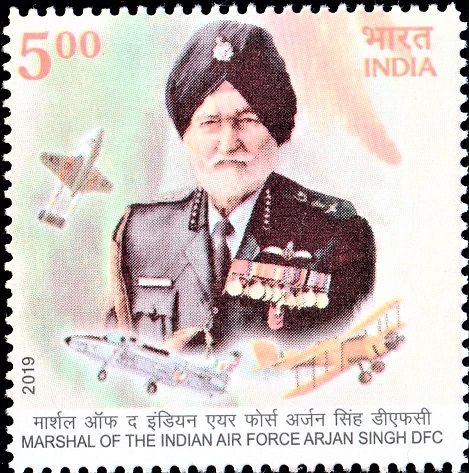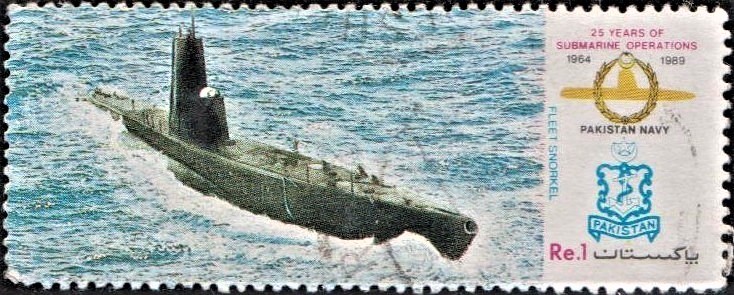
Indian Armed Forces
A commemorative postage stamp on the 50th anniversary of the Indian Armed Forces (1947-97), consists of 3 professional uniformed services: Indian Army, Indian Navy & Indian Air Force :
 Issued by India
Issued by India
Issued on Dec 16, 1997
Issued for : The Department of Posts is privileged to release a special commemorative stamp on 50 years of the Indian Armed Forces.
Design : The special commemorative stamp comprises of three bands from the left signifying the tricolour, blending into the service colours of deep red, navy blue and sky blue for the Army, Navy and Air Force respectively. Icons easily identifiable with the three services are depicted on the service colours : tank, battle ship and fighter aircraft. The first day cover has the joint services crest (Anchor for the Navy, swords for the Army and the hawk for the Air Force).
Credits :
Stamp & FDC : Army Headquarter, New Delhi.
Cancellation : Smt. Alka Sharma
Type : First Day Cover
Colour : Multi Colour
Denomination : 200 Paise
Overall size : 3.91 x 2.90 Cms.
Printing size : 3.55 x 2.54 Cms.
Perforation : 13 x 13
Paper : Imported un w/m Adhesive Gravure Coated Stamp Paper in sheets 50.8 x 53.5 cms.
Stamps Printing : 7 Million
Number per issue sheet : 35
Printing Process : Photogravure
Printer : India Security Press, Nasik
About :
- The Indian Armed Forces have a long tradition of valour and courage. They have played a vital role, in safeguarding the frontiers, protecting the nation in times of war, and more recently in peace-keeping operations and disaster management.
- After the country achieved independence, the Indian Army, Navy and Air Force displayed immaculate coordination, outstanding valour and exemplary gallantry while countering the hostilities across our borders and demonstrated the innate power and punch of the Indian’s Armed Forces on every occasion.
- The Indian Navy, along with the Indian Army helped establish effective control and achieved the integration of states like Goa, Daman & Diu and Junagarh. In the 1965 war the Indian Army and the Indian Air Force fought alongside supporting each other’s efforts, notably in the Chamb Jhaurian Sector. Operations in 1971, again displayed close cooperation along the three services and the highest standards of political and military leadership. The heroic deeds of our officers and men, form a part of the history of India. As India celebrates 50 years of its independence, it is a time to pay homage to those who laid down their lives in the service of the nation.
- When India was not at war, the Armed Forces continued to protect our frontiers and help in fighting insurgency within the country. Their efforts at peace-keeping and disaster relief, over the years, cannot be over-emphasized. The Indian Armed Forces have also been contributing to the efforts of the UN Peace-keeping Forces, whenever they have been called upon.
- Apolitical, multi-religious and multi-ethnic, the Indian Armed Forces demonstrate the true character of the Indian fabric : integrated and united.
- If the last 50 years have presented the Indian Armed Forces with challenges, the next 50 years may present new ones. India can expect them to perform acts of even greater courage, ingenuity and integrity to preserve her independence, democratic tradition and her booming economy.
- Text : Army Headquarter, New Delhi.








[…] supply of arms, ammunition and other items to the Armed Forces, the needs of police and the para military organizations are also catered to. Items are also […]
[…] R&D organization involved in design and development of indigenous defence systems for the Indian Armed Forces. The organization has contributed immensely in making India a self-sufficient and self-reliant […]
[…] services. The tactical support that our scientists and technologists have provided to the armed forces through design and fabrication of a wide range of tactical missiles, combat aircraft, armour and […]
[…] Indian Armed Forces, have a long tradition of valour and courage, in the face of overwhelming odds. No where was this […]
[…] selfless service and the spirit of sacrifice are ingrained tenets of the Indian Armed Forces, preserved as part of their glorious tradition, enabling them to acquit themselves commendably both […]
[…] the Academy. Till date, close to 25000 alumni of the Academy have served or are serving in the Armed Forces of Indian as well as a number of friendly countries after having imbibed academic and military […]
[…] MITS, Gwalior scaled heights in government organizations such as Union Public Service Commission, Armed Forces, Indian Space Research Organization, Aeronautical Development Establishment, SIDBI, Airport […]
[…] and postgraduate medical, nursing and paramedical cadets, officers and personnel of the Indian Armed Forces and friendly countries so as to cater to the health care needs of the Armed Forces personnel and […]
[…] 1972 in recognition of its specific role in boosting and improving the communication network of the Indian Armed Forces. The Soldier’s mail never misses him whatever he is placed – be it on the dizzy heights of […]
[…] has also maintained its old tradition of giving introductory training as a preparation for the armed forces. Today, the school has the distinction of sending a number of boys to the National Defence Academy. […]
[…] Indian Navy is normally reviewed by the President, in his capacity as Supreme Commander of the Armed Forces, once during his tenure in office. Dr. Rajendra Prasad, the first President of the Republic of […]
[…] Jawan has met the challenge of the aggressor. Officers and men of our armed forces have lived up to their traditions of valour, heroism and, fortitude. They stand vigil today, all […]
[…] World Games 07. The formal signing of Invitation for participating countries, between CISM and Indian Armed Forces took place on 26 September 2006 at […]
[…] too, it is a time honoured tradition that the President of India, as the Supreme Commander of the Armed Forces, reviews the Naval Fleet once during her/his tenure. Nine such reviews have taken place since […]
[…] Posts and Telegraphs Department have on various occasions highlighted the significance of the armed forces in the country’s service by issuance of commemorative postage stamps and they are proud to […]
[…] among the youth of the country. The aim of NCC training is not only to produce material for the armed forces but also to provide leaders for other fields of our national activities and to inculcate defence […]
[…] role to play – with new goals to spur them on and new aspirations. Now to the Armed Forces fell the mantle of defending the sacred Motherland from external […]
[…] India and Bangladesh also celebrate the 50th anniversary of the 1971 Liberation War, where the Indian armed forces fought shoulder-to-shoulder with the Muktijoddhas, and the millions who made the ultimate sacrifice […]
[…] to India” was another slogan used by him and later adopted by the Government of India and the Indian Armed Forces. Netaji was considered a patriot even by some of his rivals in the Congress. Gandhi himself wrote […]
[…] independence, traditionally, the President, as the Supreme Commander of the Indian Armed Forces reviews the Fleet once during his tenure. In this most formal of naval ceremonies, ships, […]
[…] and to help in refugee management, the need for an exclusive postal arrangement was felt by the Army. 56 APO came back from Iwakuni, Japan, in 1947 after WWII, it formed the nucleus of what later came […]
[…] President of India being the Supreme Commander of the Armed Forces, once in his term, reviews the Indian Naval Fleet as part of the ‘President’s Fleet […]
[…] club which was established by the British for the use of officers of the Indian Civil Services, Armed Forces and residents of Delhi. It was established on 3rd July, 1913 as the Imperial Delhi Gymkhana […]
[…] The Officers Training Academy (OTA), Chennai was established on 1st January, 1963 as a premier military institution to provide pre-commissioning training to the civilians inducted in the Armed Forces. […]
[…] support for cutting-edge technology as Defence Minister (1982-84) won him appreciation from the Armed Forces as well as the scientist’s […]
[…] On 15 February 2011, the Corps of Signals completed 100 years of its service to the Armed Forces. […]
[…] in the East. The war became an example of perfect coordination between the three units of the Armed Forces and stands out as one of the fastest military victories in the history of. With the Shimla […]
[…] of the secular and liberal ideals which motivate our nation. The unity and courage with which the Armed Forces thwarted external aggression should serve as an example to us […]
[…] with the object of providing training to boys of Indian domicile wishing to become officers in the Armed Forces. The genesis of the institution lay in the fact that a concerted push for the Indianisation of […]
[…] Year 2021 marks the 50th Anniversary of the victory of the Indian Armed Forces during the 1971 Indo-Pak War. As a mark of tribute and celebration of the victory, the period […]
[…] and a place of ultimate choice for entrepreneurs all over the world. Every tenth soldier in the Armed Forces is from Haryana. The State is the second largest contributor of foodgrains to the Central Pool. It […]
[…] the long and glorious history of the Indian Army, Army Post Offices have played a pivotal role in maintaining the morale of the troops. Being a part […]
[…] any challenge. Post-Independence, traditionally, the President, as the Supreme Commander of the Indian Armed Forces reviews the Fleet once during his tenure. After a 21-gun salute, the President embarks on the […]